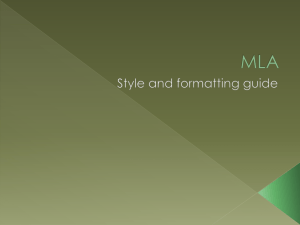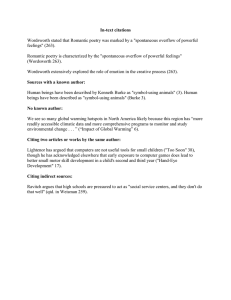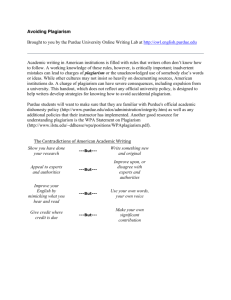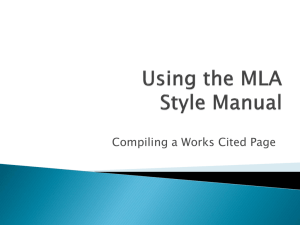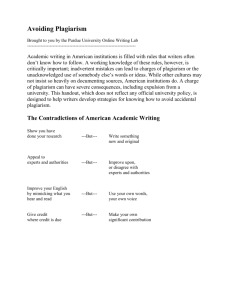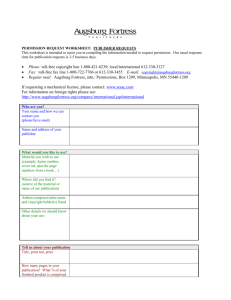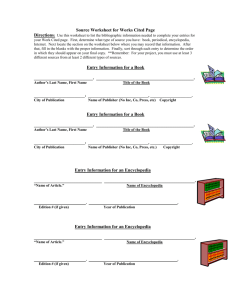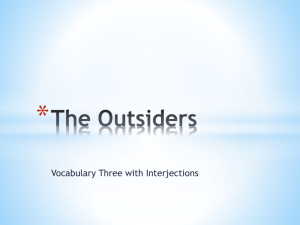Obridge Student Plagiarism Document
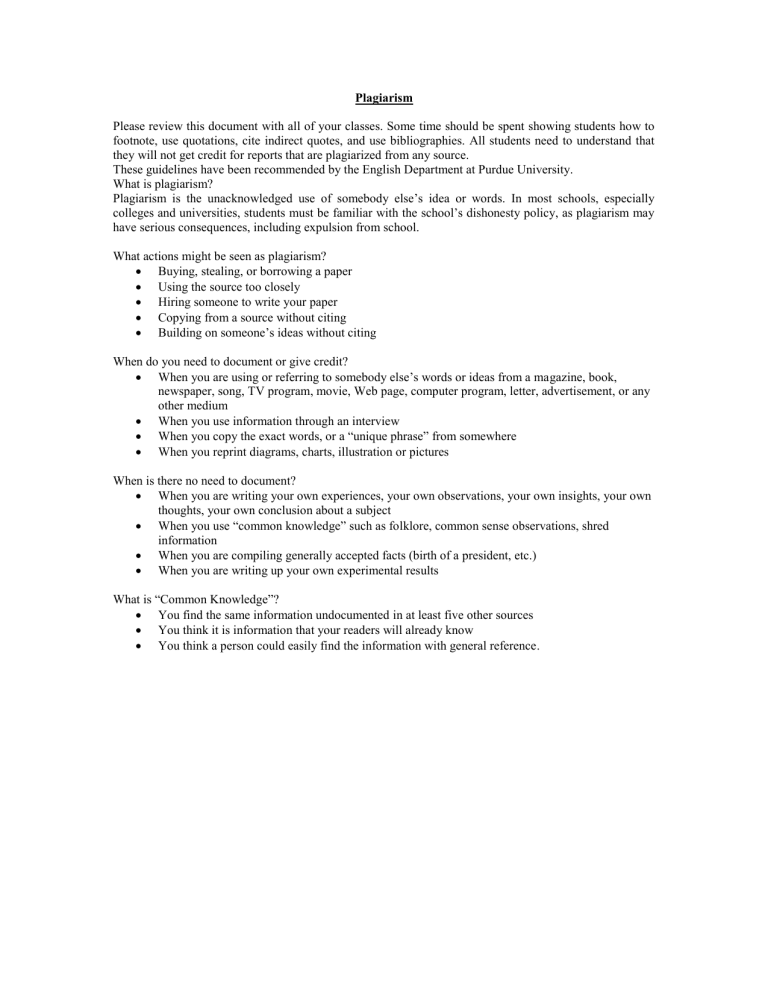
Plagiarism
Please review this document with all of your classes. Some time should be spent showing students how to footnote, use quotations, cite indirect quotes, and use bibliographies. All students need to understand that they will not get credit for reports that are plagiarized from any source.
These guidelines have been recommended by the English Department at Purdue University.
What is plagiarism?
Plagiarism is the unacknowledged use of somebody else’s idea or words. In most schools, especially colleges and universities, students must be familiar with the school’s dishonesty policy, as plagiarism may have serious consequences, including expulsion from school.
What actions might be seen as plagiarism?
Buying, stealing, or borrowing a paper
Using the source too closely
Hiring someone to write your paper
Copying from a source without citing
Building on someone’s ideas without citing
When do you need to document or give credit?
When you are using or referring to somebody else’s words or ideas from a magazine, book, newspaper, song, TV program, movie, Web page, computer program, letter, advertisement, or any other medium
When you use information through an interview
When you copy the exact words, or a “unique phrase” from somewhere
When you reprint diagrams, charts, illustration or pictures
When is there no need to document?
When you are writing your own experiences, your own observations, your own insights, your own thoughts, your own conclusion about a subject
When you use “common knowledge” such as folklore, common sense observations, shred information
When you are compiling generally accepted facts (birth of a president, etc.)
When you are writing up your own experimental results
What is “Common Knowledge”?
You find the same information undocumented in at least five other sources
You think it is information that your readers will already know
You think a person could easily find the information with general reference.
The following is a chart that Purdue University put together for their students to help them make sure they are safe when they take notes and write a report:
During the writing process
When researching, note-taking, and interviewing
When paraphrasing and summarizing
big Q (for Quote ) or with big quotation marks.
Indicate in your notes which ideas are taken from sources
First, read you text, and then write your paraphrase or summary without looking at the original text, so you rely
(
Mark everything that is someone else’s words with a
S ) and which are your own insights ( ME your notes
)
Record all documentation in only on your memory
Next, check your version with the original for content, accuracy, and mistakenly borrowed phrases
What it looks like on your finished paper
Proofread and check notes to make sure that anything taken from your notes is acknowledged in some combination of the ways below:
In-text citation
Footnotes
Bibliography
Quotation marks
Indirect quotations
Begin your summary by giving credit to the source:
According to Walter Dean
Myers…
Put any unique words or phrases that you cannot change, or do not want to change, in quotation
When quoting directly marks:…”savage inequalities” exist throughout our educational system
(Kozol)
Mention the person’s name Keep the person’s name near the quote in your notes and in your paper
Select direct quotes that
When quoting indirectly
make the most impact in your paper. Don’t use too many direct quotes
Keep the person’s name near the text in your notes, and in your paper
Rewrite the key ideas using different words and sentence structure than the original text either at the beginning of the quote, in the middle, or at the end
Put quotation marks around the text that you are quoting
Indicate added phrase in backets ( ) and omitted text with ellipses (…)
Mention the person’s name either at the beginning of the information, or in the middle, or at the end
Double check to make sure that your words and sentence structures are different than the original text
How do I reference a source?
Books
Format:
Author(s), Title of Book. Place of Publication: Publisher, Year of Publication.
Example:
Henley, Patricia. The Hummingbird House, Denver: MacMurray, 1999.
Book with more than one author:
Gillespie, Paula, and Neal Lerner. The Allyn and Bacon Guide to Peer Tutoring, Boston: Allyn, 2000.
Article From Reference Book
Format:
Author. “Title of Article.” Book Title. Place of Publication: Publisher, Year. Pages used (Simply omit any information that is not available)
Example:
King, Martin Luther. “I Have a Dream.” Speeches: The Collected Wisdom of Martin Luther King.
Washington: King Press, 1971. 10 – 11
Article in a General Encyclopedia
Format:
“Title of Article.” Title of Encyclopedia. Year of Publication. Pages Used.
Example:
“Mandarin.” The Encylopedia Americana. 1994.200.
Book or Reference Material With An Editor
Format:
Last name, First name, ed. “Title of Article.” Title of Book. Place of Publication: Publisher, Year.
Example:
Van Creveld, Martin, ed. “Adolph Hitler.” The Encyclopedia of Revolutions and Revolutionaries. New
York: Facts on File, 1996.
Book by a Corporate Author/Organization
Format:
Corporate Author, Title of Book. Place of Publication: Publisher, Year.
Example:
National Research Council. Beyond Six Billion: Forecasting the World’s Population. Washington: National
Academy, 2000.
Magazine and Newspaper Articles
Format:
Author(s). “Title of Article.” Title of Source. Day Month Year: pages
Example:
Poniewozik, James. “TV Makes a Too-Close Call.” Time 20 Nov. 2000: 70-71
WEBSITE
Format:
Author(s). Name of Pages. Date of Posting/Revision. Name of institution/organization affiliated with the site. Date of Access <electronic address>. (Omit any information that is not available)
Example:
Felluga, Dino. Undergraduate Guide to Literary Theory. 17 Dec. 1999. Purdue University. 15 Nov.2000
<http://omni.cc.purdue.edu%7Efelluga/theory2.html>.
It is necessary to list your data of access because web postings are often updated, and information available at one date may no longer be available later. Be sure to include the complete address for the site. Also, note the use of angled brackets around the electronic address; MLA requires them for clarity.
Magazine and Newspaper Article Accessed Online
Format:
Author. “Article Title.” Periodical. Date of Access <URL address>
Example:
“Customer’s Attempt to Complain to Manager Thwarted by Employee.” The Onion14 Feb 2001 http://the onion.com/onion3705/atempt-to-complain.html
An Article or Publication from an Online Database
Format:
Author. “Title of Article” Publication Name Volume Number (if necessary) Publication Date: page number-page number. Database name. Service name. Library Name, City, State. Date of access <electronic address of the database>
An Online Image
Format:
Artist if available. ”Description or title of image.” Date of image. Online image. Title of larger site. Date of download. <electronic address>
Example:
Smith, Greg. “Rheses Monkeys in the Zoo.” No date. Online image. Monkey Picture Gallery 3 May 2003. http://monkeys.online.org/rhesus.jpg
.
Film
Format:
Title of Film, Name of Director. Lead Roles. Production Company, Year
Example:
The Ususal Suspects. Dir. Bryan Singer. Perf. Kevin Spacey, Gabrial Byrne, Chazz Palminteri, Stephen
Baldwin, and Benecio del Toro. Polygram, 1995.
Taken from: Riverdale Knightsbridge Academy, New York City and the Purdue OWL.
